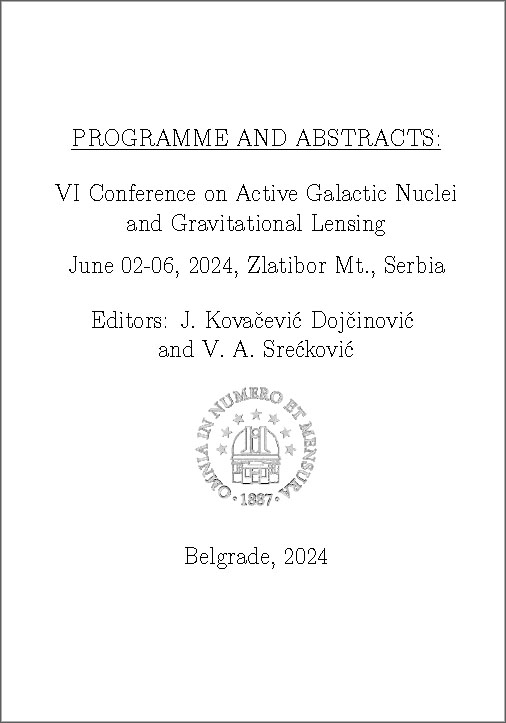Publication
PROGRAMME AND ABSTRACTS: VI Conference on Active Galactic
Nuclei and Gravitational Lensing, June 02-06, 2024, Zlatibor Mt.,
Serbia. Editors: J. Kovačević Dojčinović and V. A. Srećković
Nuclei and Gravitational Lensing, June 02-06, 2024, Zlatibor Mt.,
Serbia. Editors: J. Kovačević Dojčinović and V. A. Srećković
Autors
Kriti K. Gupta
Title
PHYSICAL PROPERTIES OF LENSED QUASARS USING X-RAY TO MIR DATA
Abstract
AGN are powered by mass accretion and emit radiation over the entire electromagnetic spectrum. This multi-wavelength emission originates at different physical scales via different physical processes. Hence, a detailed analysis of the broadband spectral energy distributions (SEDs) of AGN can provide fundamental insights into their accretion physics and can be used to estimate important physical quantities, such as bolometric luminosities, black hole masses, and Eddington ratios. For gravitationally lensed quasars, we are usually missing this information which is crucial to understand the role of microlensing on the different emitting regions.
I will present an ongoing effort to derive this information for a sample of optically-selected quadruply-imaged quasars for which we have compiled photometric and spectroscopic data from the X-rays to mid-infrared from various ground- and space-based observatories, including HST, JWST, Chandra, LCO, Paranal, etc. Specifically, I constructed and fitted their multi-wavelength SEDs to estimate their bolometric luminosities and used MgII λ2798 and/or CIV λ1549 line widths to calculate their black hole masses and Eddington ratios. A preliminary overview of the physical properties of the population of lensed quasars and how they compare with non-lensed AGN will be presented. In addition, I will discuss how those estimates can be used to prioritize systems that require follow-up and for which microlensing can be used as a tool to study the accretion disk, broad-line region, and torus.
I will present an ongoing effort to derive this information for a sample of optically-selected quadruply-imaged quasars for which we have compiled photometric and spectroscopic data from the X-rays to mid-infrared from various ground- and space-based observatories, including HST, JWST, Chandra, LCO, Paranal, etc. Specifically, I constructed and fitted their multi-wavelength SEDs to estimate their bolometric luminosities and used MgII λ2798 and/or CIV λ1549 line widths to calculate their black hole masses and Eddington ratios. A preliminary overview of the physical properties of the population of lensed quasars and how they compare with non-lensed AGN will be presented. In addition, I will discuss how those estimates can be used to prioritize systems that require follow-up and for which microlensing can be used as a tool to study the accretion disk, broad-line region, and torus.




